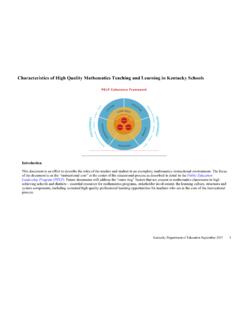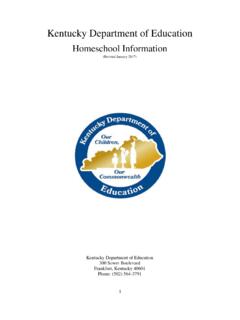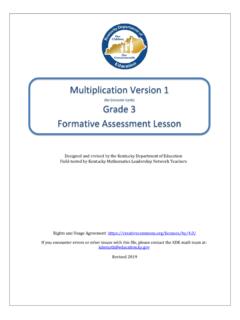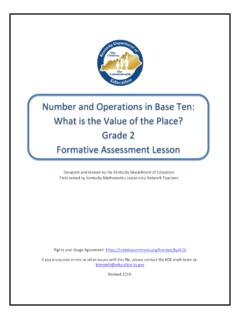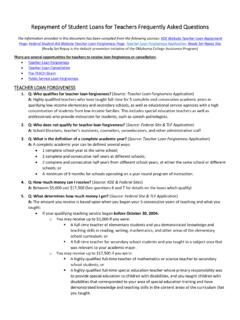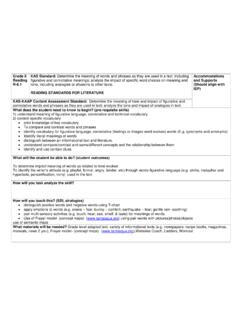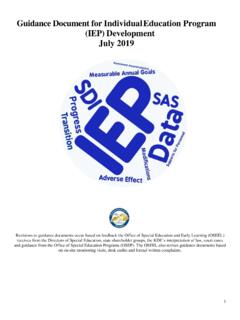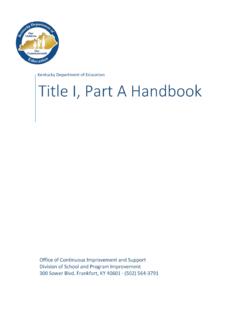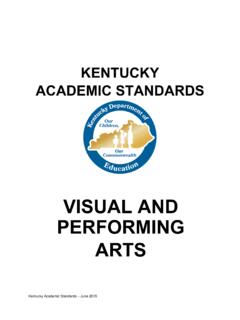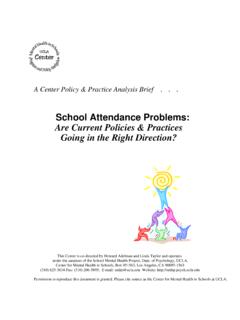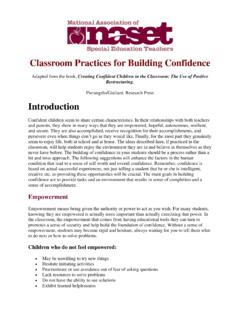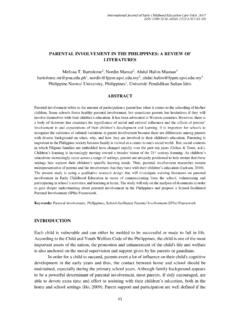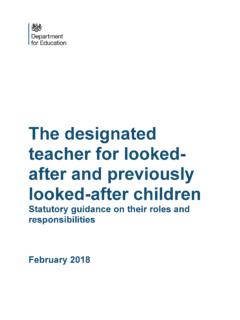Transcription of Kentucky Academic Standards Mathematics
1 1 Kentucky Academic Standards Mathematics Adopted 7/1/192 TABLE OF CONTENTS INTRODUCTION .. 4 Background .. 4 Kentucky s Vision for students .. 4 Legal Basis .. 5 Standards Creation Process .. 6 Writers Vision Statement .. 6 Design Considerations .. 7 The Modeling Process .. 8 Standards USE AND DEVELOPMENT .. 9 The Kentucky Academic Standards (KAS) are Standards , not Curriculum .. 9 Translating the Standards into Curriculum .. 10 Organization of the Standards .. 10 How to Read the Coding of the Standards .. 11 Additional High School Coding .. 12 Standards for Mathematical Practices.
2 12 Connecting the Standards for Mathematical Practice to the Standards for Mathematical Content .. 15 Supplementary Materials to the Standards .. 15 Kentucky Academic Standards for Mathematics : Kindergarten Overview .. 16 Kentucky Academic Standards for Mathematics : Grade 1 Overview .. 29 Kentucky Academic Standards for Mathematics : Grade 2 Overview .. 45 Kentucky Academic Standards for Mathematics : Grade 3 Overview .. 60 Kentucky Academic Standards for Mathematics : Grade 4 Overview .. 76 Kentucky Academic Standards for Mathematics : Grade 5 Overview .. 97 Kentucky Academic Standards for Mathematics : Grade 6 Overview.
3 116 3 Kentucky Academic Standards for Mathematics : Grade 7 Overview .. 136 Kentucky Academic Standards for Mathematics : Grade 8 Overview .. 154 Kentucky Academic Standards for Mathematics : Conceptual Category Number and Quantity .. 171 Kentucky Academic Standards for Mathematics : Conceptual Category Algebra .. 182 Kentucky Academic Standards for Mathematics : Conceptual Category Functions .. 195 Kentucky Academic Standards for Mathematics : Conceptual Category Geometry .. 210 Kentucky Academic Standards for Mathematics : Conceptual Category Statistics and Probability .. 229 Kentucky Academic Standards for Mathematics : Calculus (+).
4 241 Appendix A: Tables .. 254 Appendix B: Writing and Review Committees .. 259 4 Kentucky Academic Standards Mathematics INTRODUCTION Background In order to create, support and sustain a culture of equity and access across Kentucky , teachers must ensure the diverse needs of all learners are met. Educational objectives must take into consideration students ' backgrounds, experiences, cultural perspectives, traditions and knowledge. Acknowledging and addressing factors that contribute to different outcomes among students are critical to ensuring all students routinely have opportunities to experience high-quality Mathematics instruction, learn challenging Mathematics content and receive the necessary support to be successful.
5 Addressing equity and access includes both ensuring all students attain Mathematics proficiency and achieving an equitable percentage of all students attaining the highest levels of Mathematics achievement (Adapted from the National Council of Teachers of Mathematics Equity and Access Position, 2018). Kentucky s Vision for students Knowledge about Mathematics and the ability to apply Mathematics to solve problems in the real world directly align with the Kentucky Board of Education s (KBE) vision that each and every student is empowered and equipped to pursue a successful future. To equip and empower students , the following capacity and goal statements frame instructional programs in Kentucky schools.
6 They were established by the Kentucky Education Reform Act (KERA) of 1990, as found in Kentucky Revised Statute (KRS) and KRS All students shall have the opportunity to acquire the following capacities and learning goals: Communication skills necessary to function in a complex and changing civilization; Knowledge to make economic, social and political choices; Core values and qualities of good character to make moral and ethical decisions throughout life; Understanding of governmental processes as they affect the community, the state and the nation; Sufficient self-knowledge and knowledge of their mental health and physical wellness; Sufficient grounding in the arts to enable each student to appreciate their cultural and historical heritage; Sufficient preparation to choose and pursue their life s work intelligently; and Skills to enable students to compete favorably with students in other states Furthermore, schools shall: Expect a high level of achievement from all students .
7 Develop their students ability to: o Use basic communication and Mathematics skills for purposes and situations they will encounter throughout their lives; 5 o Apply core concepts and principles from Mathematics , the sciences, the arts, the humanities, social studies, English/language arts, health, practical living, including physical education, to situations they will encounter throughout their lives; o Become self-sufficient individuals; o Become responsible members of a family, work group or community as well as an effective participant in community service; o Think and solve problems in school situations and in a variety of situations they will encounter in life; o Connect and integrate experiences and new knowledge from all subject matter fields with what students have previously learned and build on past learning experiences to acquire new information through various media sources; o Express their creative talents and interests in visual arts, music, dance, and dramatic arts.
8 Increase student attendance rates. Reduce dropout and retention rates. Reduce physical and mental health barriers to learning. Be measured on the proportion of students who make a successful transition to work, postsecondary education and the military. To ensure legal requirements of these courses are met, the Kentucky Department of Education (KDE) encourages schools to use the Model Curriculum Framework to inform development of curricula related to these courses. The Model Curriculum Framework encourages putting the student at the center of planning to ensure that ..the goal of such a curriculum is to produce students that are ethical citizens in a democratic global society and to help them become self-sufficient individuals who are prepared to succeed in an ever-changing and diverse world.
9 Design and implementation requires professionals to accommodate the needs of each student and focus on supporting the development of the whole child so that all students have equitable access to opportunities and support for maximum Academic , emotional, social and physical development. (Model Curriculum Framework, page 19) Legal Basis The following Kentucky Administrative Regulations (KAR) provide a legal basis for this publication: 704 KAR 8:040 Kentucky Academic Standards for Mathematics Senate Bill 1 (2017) calls for the KDE to implement a process for establishing new, as well as reviewing all approved Academic Standards and aligned assessments beginning in the 2017-18 school year.
10 The current schedule calls for content areas to be reviewed each year and every six years thereafter on a rotating basis. The KDE collects public comment and input on all of the draft Standards for 30 days prior to finalization. Senate Bill 1 (2017) called for content Standards that focus on critical knowledge, skills and capacities needed for success in the global economy; result in fewer but more in-depth Standards to facilitate mastery learning; 6 communicate expectations more clearly and concisely to teachers, parents, students and citizens; are based on evidence-based research; consider international benchmarks; and ensure the Standards are aligned from elementary to high school to postsecondary education so students can be successful at each education level.
